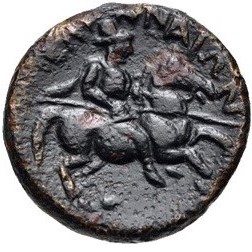Title: Dichalkon of Pelinna - 2018.05
Acquisition number: 2018.05
Author or editor: Peter Londey
Culture or period: Hellenistic.
Date: Late 4th - 3rd centuries BC.
Material: Metal - Bronze
Object type: Coins - Greek
Dimensions: 16mm (w)
Origin region or location: Greece
Origin city: Pelinna
Display case or on loan: 5
Keywords: Coin, Greek, dichalkon, Pelinna, Thessaly, Manetho, Mantho, Manto
Classical Numismatic Group, TheBCD Collection of the Coinage of Thessaly (Auction XV [3 January 2012], Lancaster PA and London, Triton, 2012), II, 534.1.
O. Hoover, Handbook of Greek Coinage 13 vols (Classical Numismatic Group, Lancaster, PA, 2009-2013), 4, 275.
Classical Numismatic Group Auction, 431 lot 111.
2018.05
Dichalkon of Pelinna
Bronze 6.05 g. 16 mm. late 4th-3rd centuries BC.
Obv.: veiled head of local sibyl Manetho/Manto?
Rev.: Helmeted Thessalian Horse rider charging right holding spear, [ΠΕΛΙ]ΝΝΑΙΩΝ (of the people of Pelinna)
Purchased by the Friends of the ANU Classics Museum in memory of Jill Greenwell.
Pelinna was a city on the Peneios River in north-west Thessaly. Little is known of its history, though it boasted a large 5th century BC acropolis and extensive 4th century walls. Pelinna often seems to have been at odds with the other Thessalian cities. In 431, it was not one of the six Thessalian cities which sent contingents to fight for Athens (Thuc. 2.22.3). In the 4th century, according to a late source (Polyainos 4.2.19), there was a war between Pelinna and Pharsalos.
Citizens of Pelinna served in various capacities at Delphi, including on occasion under Alexander the Great providing one of the two Thessalian hieromnemones (members of the Amphiktyonic Council). Later, after Alexander’s death, Pelinna remained a loyal supporter of Makedonia, and according to Diodoros (18.11.1) was the only Thessalian city which did not join the anti-Makedonian Hellenic alliance in the Lamian War (323–322 BC). .
The reverse, with its image of an armed soldier on horseback is typical of Thessalian coins. Unlike much of southern Greece, Thessaly had wide grazing lands and was noted for its horses and cavalry. It is generally assumed that the female figure on the obverse is the Thessalian sibyl Manetho (or Manto), though little is known about her cult.
Classical Numismatic Group, TheBCD Collection of the Coinage of Thessaly (Auction XV [3 January 2012], Lancaster PA and London, Triton, 2012), II, 534.1.
O. Hoover, Handbook of Greek Coinage 13 vols (Classical Numismatic Group, Lancaster, PA, 2009-2013), 4, 275.
Classical Numismatic Group Auction, 431 lot 111.

